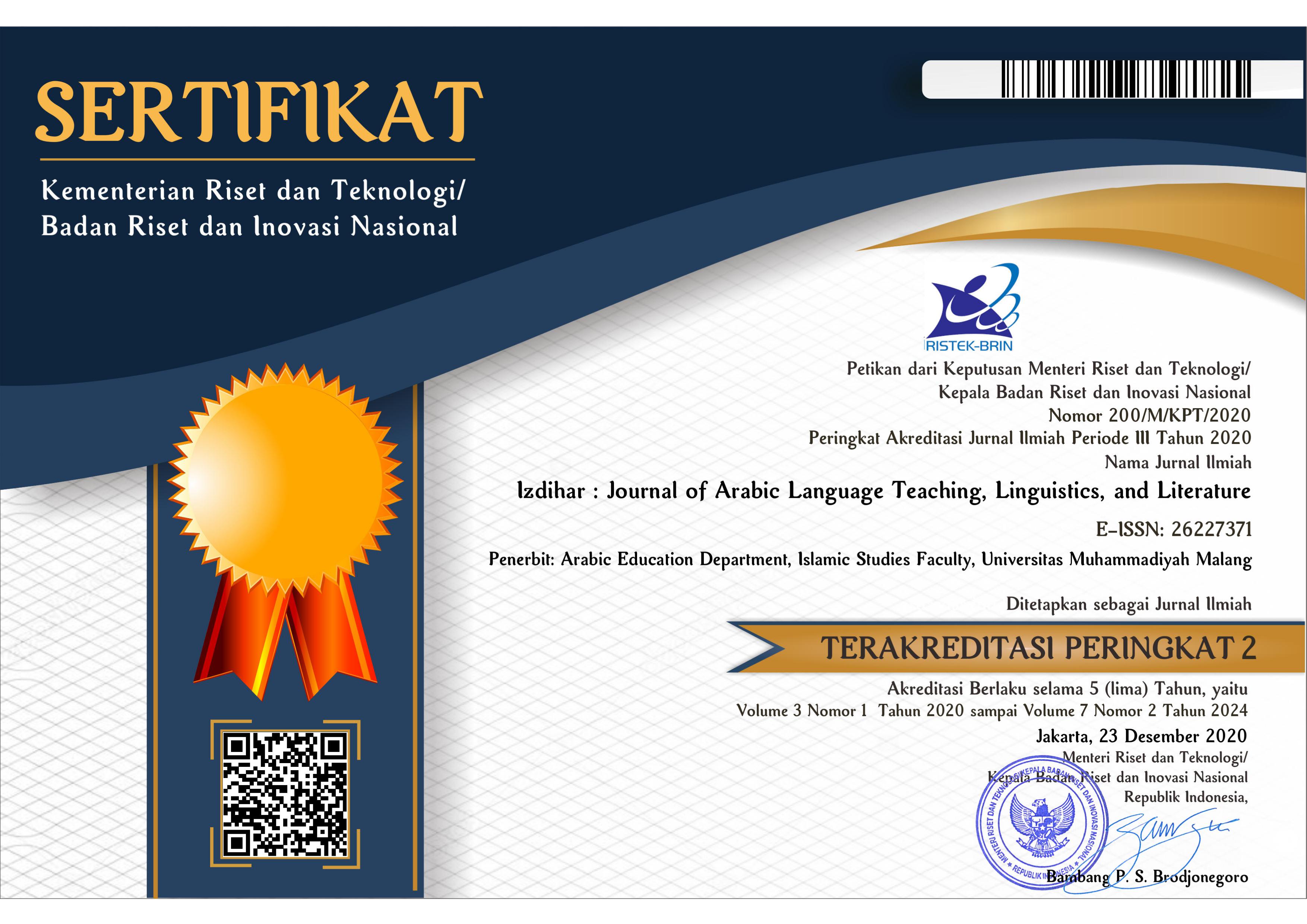Interactive Electronic Book (IE-Book) of Arabic Speech Material for Undergraduate Students
DOI:
https://doi.org/10.22219/jiz.v5i3.22907Keywords:
Arabic Speech, IE-Book, Need Analysis, Public SpeakingAbstract
This research aimed to find students' and lecturers' needs for Arabic speech material design with an interactive electronic book (IE-Book) model for undergraduate students. Currently, books for this material are limited and do not fulfill the students' needs. This need analysis study used the descriptive analysis method: the data was collectedrom observation, interview, questionnaire, and other supporting documents. Then the data analysis technique used a judgment expert. There were four steps to analyze the data; data collection, data reduction, data display, and conclusion. This research indicated that 72% of the students had difficulty learning Arabic speech. At the same time, 73% of students struggle to make excellent and correct Arabic speech. IE-Book for Arabic public speaking design is the proper and best solution to be used as guidance for speech courses and learning processes in Arabic speaking material at universities based on the problem above and students’ needs analysis that showed the high level for designing of alternative materials.
Downloads
References
’Athiyyah, M. ’Athiyyah al-S. A. (2022). Tashmim kitab iliktruniy tafa’uli qo’im ’ala barnamij al-qura’iyyah li tanmiyati al-tahshil al-qurra’i fi al-lughah al-’arabiyyah lada talamidz al-shaff al-tsalits al-ibtida’i. Al-Majallah Al-’ilmiyyah Al-Mahkamah Li Dirasati Wa Buhuts Al-Tarbiyyah Al-Nau’iyyah, 8(1).
Abella, R. C., & Cutamora, J. C. (2019). Approach To Public Speaking Skills Development in an Educational Organization: a Grounded Theory. European Journal of Education Studies, 6(3), 232–264. https://doi.org/10.5281/zenodo.3261608
Aburezeq, I. M. (2020). The Impact of Flipped Classroom on Developing Arabic Speaking Skills. Asia-Pacific Education Researcher, 29(4), 295–306. https://doi.org/10.1007/s40299-019-00483-z
Al-Khresheh, M. H., Khaerurrozikin, A., & Zaid, A. H. (2020). The efficiency of using pictures in teaching speaking skills of non-native arabic beginner students. Universal Journal of Educational Research, 8(3), 872–878. https://doi.org/10.13189/ujer.2020.080318
Aladdin, A. (2016). A Needs Analysis for the Course Materials Design of the Arabic Language Course. International Journal of Social Science and Humanity, 6(6), 423–426. https://doi.org/10.7763/ijssh.2016.v6.684
Asrowi, Hadaya, A., & Hanif, M. (2019). The Impact of Using the Interactive E-Book on Students' Learning Outcomes. International Journal of Instruction, 12(2), 709–722. https://doi.org/10.1088/1742-6596/1320/1/012038
Brosh, H. Y. (2019). Arabic language-learning strategy preferences among undergraduate students. Studies in Second Language Learning and Teaching, 9(2), 351–377. https://doi.org/10.14746/ssllt.2019.9.2.5
Bylkova, S., Chubova, E., & Kudryashov, I. (2021). Public speaking as a tool for developing students' communication and speech skills. E3S Web of Conferences, 273. https://doi.org/10.1051/e3sconf/202127311030
Çağrı Bozkırlı, K., & Er, O. (2018). Investigating teacher views on improving the speaking skills of Syrian students. European Journal of Education Studies, 4(6), 66–79. https://doi.org/10.5281/zenodo.1239901
Cook, W. R. A. (2017). More vision than renaissance: Arabic as a language of science in the UAE. Language Policy, 16(4), 385–406. https://doi.org/10.1007/s10993-016-9413-3
Darancik, Y. (2018). Students' Views on Language Skills in Foreign Language Teaching. International Education Studies, 11(7), 166–178. https://doi.org/10.5539/ies.v11n7p166
Gorsev, S. (2021). Impact Perfectionism and Self-Compassion Feelings of Undergraduate Students on Their Foreign Language Speaking Anxiety. Psycho-Educational Research Reviews, 10(2), 230–240. https://www.journals.lapub.co.uk/index.php/PERR
Hamid, M. F. A., Halim, Z. A., & Sahrir, M. S. (2020). An insight on needs analysis towards the development of animated infographic module in Arabic grammar learning. Journal of Language and Linguistic Studies, 16(3), 1387–1401. https://doi.org/10.17263/jlls.803813
Hidayah, N., Muhaiban, M., Mahliatussikah, H., & Ain, N. (2021). Development of "Kupancar": A Guidebook and A Collection of Arabic-Speaking Host Texts. Izdihar : Journal of Arabic Language Teaching, Linguistics, and Literature, 4(3), 303–318. https://doi.org/10.22219/jiz.v4i3.17684
Ivanova, T., Gubanova, N., Shakirova, I., & Masitoh, F. (2020). Educational Technology as one of the terms for enhancing public speaking skills. Universidad y Sociedad, 12(2), 154–159. https://rus.ucf.edu.cu/index.php/rus/article/view/1494
Lim, B. C. Y., Liu, L. W. L., & Choo, C. H. (2020). Investigating the Effects of Interactive E-Book towards Academic Achievement. Asian Journal of University Education, 16(3), 78–88. https://doi.org/10.24191/ajue.v16i3.10272
M. Sihotang, A., Sitanggang, F., Hasugian, N., & Saragih, E. (2021). The effective way to develop speaking skills. Journal of Language Teaching and Learning, Linguistics and Literature, 9(1), 188–196. https://doi.org/10.24256/ideas.v9i1.1777
Mangaleswaran, S., & Aziz, A. A. (2019). The Impact of the Implementation of CLT On Students' Speaking Skills. International Journal of Scientific and Research Publications (IJSRP), 9(4), p8814. https://doi.org/10.29322/ijsrp.9.04.2019.p8814
Mohd Firdaus, Y., Zulazhan, A. H., Muhammad Sabri, S., & Mohd Fauzi, A. H. (2021). Need Analysis On Developing Arabic Language M- Learning Basic Level During Covid-19. Journal of Contemporary Issues in Business and Government, 27(2), 5452–5461. https://doi.org/10.47750/cibg.2021.27.02.551
Moore, S. (2019). Language and identity in an Indigenous teacher education program. International Journal of Circumpolar Health, 78(2). https://doi.org/10.1080/22423982.2018.1506213
Muhammad Al Saadi, A., Muin (Al-Haj sa’id) Ismail, W., Azhar bin Zailani, M., Mohamad Alyatim, T., & Binti Hussin, Z. (2020). Readability of the Second Grade Arabic Language Books in the United Arab Emirates. Humanities & Social Sciences Reviews, 8(2), 773–780. https://doi.org/10.18510/hssr.2020.8286
Muhammad Kamal bin Abdul Hakim. (2019). Need Analysis of Arabic Guided Writing Material Using Task-Based Learning. Jurnal Al Bayan: Jurnal Jurusan Pendidikan Bahasa Arab, 12(2), 281–304. https://doi.org/10.24042/albayan.v%vi%i.5263
Samsun Baharun, M. N. A., Sardi, J., & Chin Shuang, G. (2021). Analyzing the Insight of Students' Needs for The Development of an Arabic Rhetoric Application Through MOOC. International Journal of Academic Research in Progressive Education and Development, 10(3), 320–336. https://doi.org/10.6007/ijarped/v10-i3/10706
Sarip, M., Rafli, Z., & Rahmat, A. (2018). Arabic Speaking Material Design Using Content and Language Integrated Learning ( CLIL ). International Journal of Humanities and Cultural Studies, 5(1), 272–286. https://www.ijhcs.com/index.php/ijhcs/article/view/3253
Sosas, R. V. (2021). Technology in teaching speaking and its effects to students learning English. Journal of Language and Linguistic Studies, 17(2), 958–970. https://doi.org/10.52462/jlls.66
Stewart, C., Stallings, L., & Roscoe, R. (2019). Growth Mindset: Associations with Apprehension, Self-Perceived Competence, and Beliefs about Public Speaking. Basic Communication Course Annual, 31, 44–69. https://ecommons.udayton.edu/bcca/vol31/iss1/6
Turabaeva, K. E. (2021). The Use of Electronic Training Materials for the Development of Language Skills and Speech Skills. International Journal of Innovative Analyses and Emerging Technology, 1(5), 10–11. http://openaccessjournals.eu
Wekke, I. S. (2017). Arabic Learning Material of Higher Education Muslim Community North Sulawesi. Dinamika Ilmu, 17(2), 175–189. https://doi.org/10.21093/di.v17i2.863
Yee, K. M., Jafre, M., & Abidin, Z. (2014). The use of public speaking in motivating ESL learners to overcome speech anxiety. International Journal on Studies in English Language and Literature (IJSELL, 2(11), 127–135. www.arcjournals.org
Zulharby, P., Rasyid, Y., & Nuruddin, N. (2019). The Characteristics of Teaching Material Arabic Speaking Skills in Higher Education. Jurnal Al-Bayan: Jurnal Jurusan Pendidikan Bahasa Arab, 11(2), 194–213. https://doi.org/10.24042/albayan.v11i2.5175
Downloads
Published
How to Cite
Issue
Section
License
Copyright (c) 2023 Amami Shofiya Al Qorin, Hanik Mahliatussikah, Kholisin

This work is licensed under a Creative Commons Attribution-ShareAlike 4.0 International License.
Copyright Notice
Authors who publish with this journal agree to the following terms:
- Authors retain copyright and grant the journal right of first publication with the work simultaneously licensed under a Creative Commons Attribution-ShareAlike 4.0 International License that allows others to share the work with an acknowledgment of the work's authorship and initial publication in this journal.
- Authors are able to enter into separate, additional contractual arrangements for the non-exclusive distribution of the journal's published version of the work (e.g., post it to an institutional repository or publish it in a book), with an acknowledgment of its initial publication in this journal.
- Authors are permitted and encouraged to post their work online (e.g., in institutional repositories or on their website) prior to and during the submission process, as it can lead to productive exchanges, as well as earlier and greater citation of published work (See The Effect of Open Access).
Copyright (c) 2019 Izdihar : Journal of Arabic Language Teaching, Linguistics, and Literature

This work is licensed under a Creative Commons Attribution-ShareAlike 4.0 International License.

















